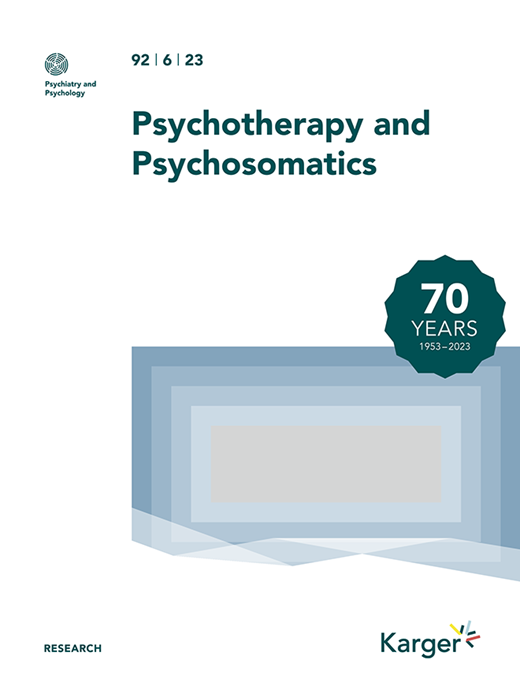Perceived Chronic Stress prior to SARS-CoV-2 Infection Predicts Ongoing Symptomatic COVID-19: A Prospective Cohort Study.
IF 17.4
1区 医学
Q1 PSYCHIATRY
引用次数: 0
Abstract
INTRODUCTION Understanding chronic stress as a potential risk factor for COVID-19 progression could inform public health measures and personalized preventive interventions. Therefore, we investigated the influence of chronic stress prior to SARS-CoV-2 infection on symptom persistence 1 month after COVID-19 onset. METHODS The participants of this prospective cohort study named "StressLoC" were adults with COVID-19 who had tested positive for SARS-CoV-2 infection within the last 7 days. Pre-existing perceived chronic stress assessed by the Perceived Stress Scale (PSS-10) was the primary predictor. The number of stressful life events and hair cortisol concentration served as additional measures of pre-existing chronic stress. The main outcome was examined using the Long COVID Symptom and Impact Tool. It was defined as the presence of any new and impactful COVID-19-related symptom at month 1 after inclusion. Accordingly, participants were assigned to either the ongoing symptomatic COVID-19 group (OSC-G) or control group. RESULTS The study cohort comprised 288 participants (73.3% female), with a median age of 46 years (IQR 35-56). A total of 210 participants (72.9%) were categorized as OSC-G. Multivariate logistic regression showed that allocation to OSC-G was predicted by perceived chronic stress in the month prior to COVID-19 (OR: 1.08, 95% CI: 1.03-1.14; p = 0.002) and the number of pre-existing symptoms (OR: 1.08, 95% CI: 1.03-1.13; p = 0.001). The number of stressful life events and hair cortisol concentration did not predict OSC-G allocation. CONCLUSIONS Results suggest that higher levels of pre-existing perceived chronic stress increase the odds of developing ongoing symptomatic COVID-19.SARS-CoV-2感染前的慢性应激可预测持续的症状性COVID-19:一项前瞻性队列研究
了解慢性压力是COVID-19进展的潜在危险因素可以为公共卫生措施和个性化预防干预提供信息。因此,我们研究了SARS-CoV-2感染前的慢性应激对COVID-19发病后1个月症状持续性的影响。方法本前瞻性队列研究“StressLoC”的参与者是在过去7天内检测出SARS-CoV-2感染阳性的COVID-19成年人。以感知压力量表(PSS-10)评估的预先存在的感知慢性压力是主要预测因子。压力生活事件的数量和头发皮质醇浓度作为预先存在的慢性压力的额外测量。使用长COVID症状和影响工具检查主要结果。定义为在纳入后第1个月出现任何新的和有影响的covid -19相关症状。因此,参与者被分配到持续症状的COVID-19组(OSC-G)或对照组。结果研究队列包括288名参与者(73.3%为女性),中位年龄为46岁(IQR 35-56岁)。共有210名参与者(72.9%)被归类为OSC-G。多因素logistic回归显示,COVID-19前一个月的慢性应激感知(OR: 1.08, 95% CI: 1.03-1.14; p = 0.002)和先前存在的症状数量(OR: 1.08, 95% CI: 1.03-1.13; p = 0.001)预测了OSC-G的分配。压力生活事件的数量和毛发皮质醇浓度不能预测OSC-G分配。结论:研究结果表明,较高水平的既往感知慢性压力会增加发生持续症状性COVID-19的几率。
本文章由计算机程序翻译,如有差异,请以英文原文为准。
求助全文
约1分钟内获得全文
求助全文
来源期刊

Psychotherapy and Psychosomatics
医学-精神病学
CiteScore
29.40
自引率
6.10%
发文量
46
期刊介绍:
Psychotherapy and Psychosomatics is a reputable journal that has been published since 1953. Over the years, it has gained recognition for its independence, originality, and methodological rigor. The journal has been at the forefront of research in psychosomatic medicine, psychotherapy research, and psychopharmacology, and has contributed to the development of new lines of research in these areas. It is now ranked among the world's most cited journals in the field.
As the official journal of the International College of Psychosomatic Medicine and the World Federation for Psychotherapy, Psychotherapy and Psychosomatics serves as a platform for discussing current and controversial issues and showcasing innovations in assessment and treatment. It offers a unique forum for cutting-edge thinking at the intersection of medical and behavioral sciences, catering to both practicing clinicians and researchers.
The journal is indexed in various databases and platforms such as PubMed, MEDLINE, Web of Science, Science Citation Index, Social Sciences Citation Index, Science Citation Index Expanded, BIOSIS Previews, Google Scholar, Academic Search, and Health Research Premium Collection, among others.
 求助内容:
求助内容: 应助结果提醒方式:
应助结果提醒方式:


